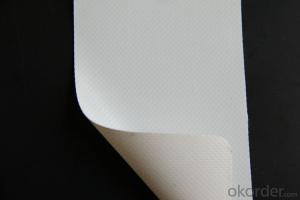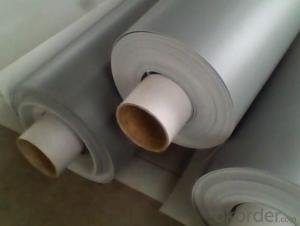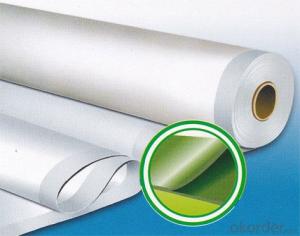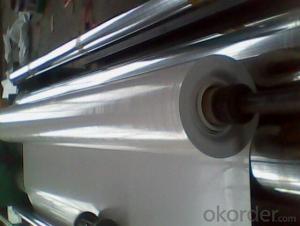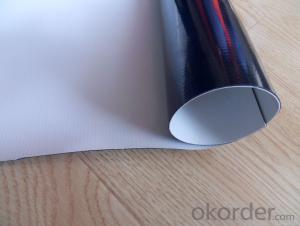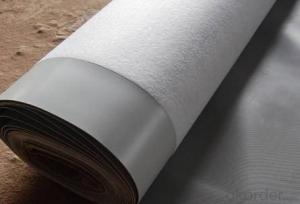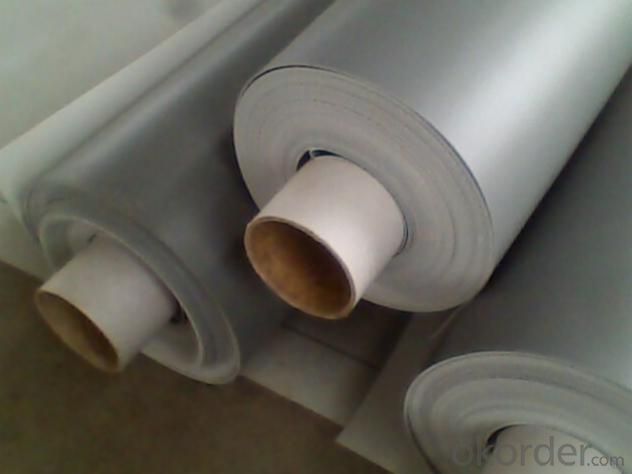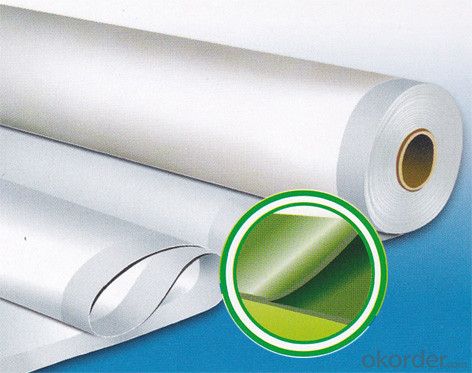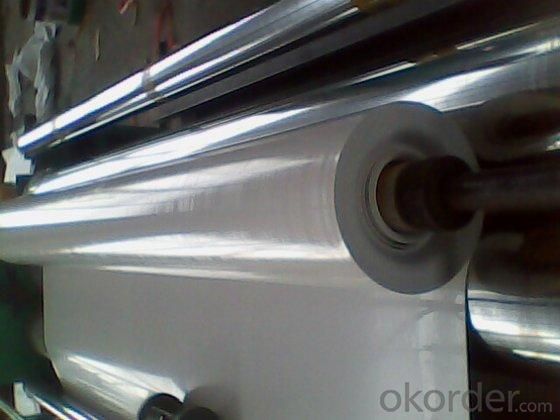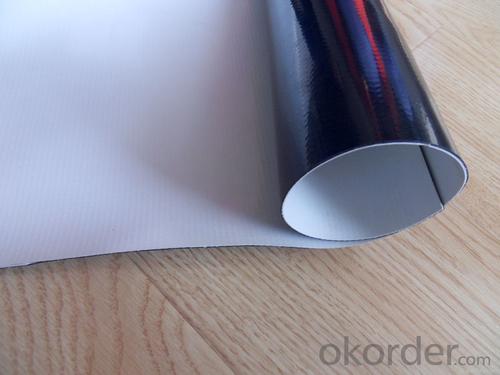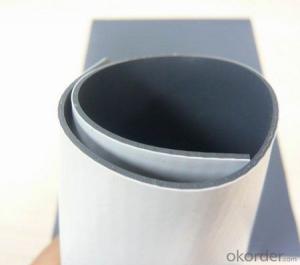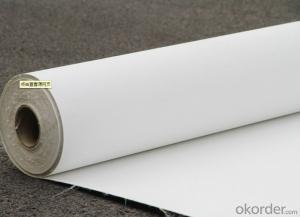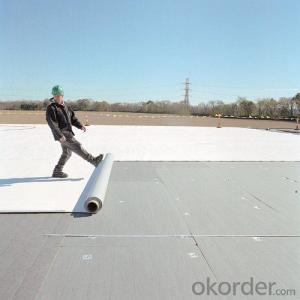PVC Waterproofing Membrane with Smooth Surface Assification
- Loading Port:
- Shanghai
- Payment Terms:
- TT OR LC
- Min Order Qty:
- 20000 m²
- Supply Capability:
- 5000000 m²/month
OKorder Service Pledge
OKorder Financial Service
You Might Also Like
PVC Waterproofing Membrane with Smooth Surface Assification
Product Description of PVC Waterproofing Membrane with Smooth Surface Assification:
PVC waterproofing membrane is an excellent high-quality polymer waterproof sheet, made of PVC resin by adding plasticizer, anti-UV agent, anti aging agent, and stabilizer and other processing aids through extrusion and molding. As the highly recommended product by the Ministry of Construction, it is featured by high tensile strength, great elongation, good stability, small shrinkage, low-temperature performances, good resistance to weathering and root
penetration, and long service life.
Features of PVC Waterproofing Membrane with Smooth Surface Assification:
1.Long service life and weathering resistance; and the materials can be used for 30 years on the roof and 50 years underground.
2. High tensile strength, great elongation, and small size change during heat treatment.
3. Good low temperature flexibility and adaptability to environmental temperature changes.
4. Good resistance to root penetration. It can be made for green roofs.
5. Excellent resistance to puncture and impact.
6. Convenient for construction (can be welded), solid and reliable, and Eco-friendly.
7. Strong resistance to chemical corrosion, suitable for special occasions.
8. Good plasticity, convenient and quick corner detail treatment. Easy maintenance and low cost.
9.After 2,000 hours of manual weathering verification
Classification of PVC Waterproofing Membrane with Smooth Surface Assification:
1. N: Homogeneous PVC membrane
2. L: PVC membrane with fabric backing
3. W: Reinforced PVC membrane
Advantage of PVC Waterproofing Membrane with Smooth Surface Assification:
1.) Mixing automation. Apply automatic temperature control automatic time control and automatic feed control.
2.) Extrusion equipment uses twin screw coextrusion. Screw temperature uses computer automatic temperature control system.
3.) Handpiece uses large width didhead extrusion equipment.
4.) Sophisticated three-roller calender equipment. The space between equiment is controlled by automation system.
Technical Data of PVC Waterproofing Membrane with Smooth Surface Assification:
No. | Item | Model Ⅱ | |
1 | Tensile Strength Mpa ≥ | 12.0 | |
2 | Elongation at break% ≥ | 250 | |
3 | Shrinkage rate % ≤ | 2.0 | |
4 | Flexibility at low temperature | No crackle at -25oC | |
5 | Water tightness | Watertight | |
6 | Puncture resistance | Watertight | |
7 | Heat aging treatment | Appearance | Free from bubble, crack, cohesion and void |
Change rate of tensile strength % | +20oC | ||
Change rate of elongation at break | |||
Flexibility at low temperature | No crack at -20oC | ||
8 | Chemical corrosion resistance | Change rate of tensile strength % | +20 |
Change rate of elongation at break | |||
Flexibility at low temperature | No crack at -20oC | ||
9 | Artificial weathering | Change rate of tensile strength % | +20 |
Change rate of elongation at break | |||
Flexibility at low temperature | No crack at -20oC | ||
Application of PVC Waterproofing Membrane with Smooth Surface Assification:
1) All kinds of roofs, such as steel structure roof, planted roof etc.
2) Underground engineering, such as building basement, subways, tunnels, air raid shelter, etc.
3) Other projects like artificial lake, dam, water reservoir, grain storehouse, etc.
Images of PVC Waterproofing Membrane with Smooth Surface Assification:
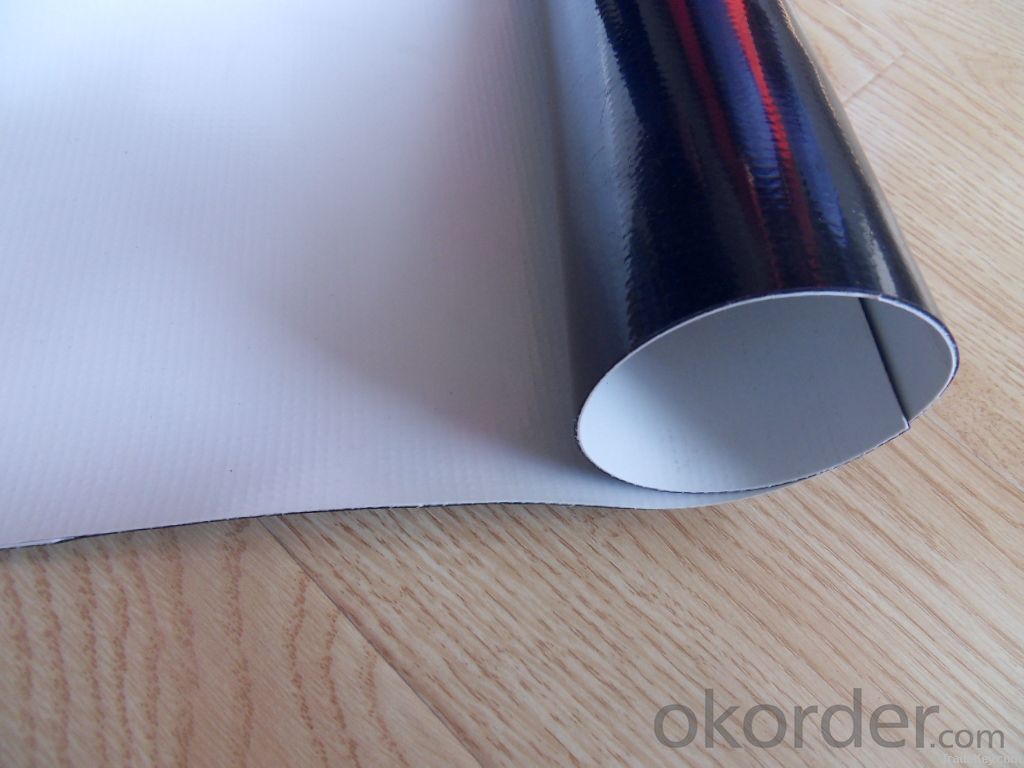
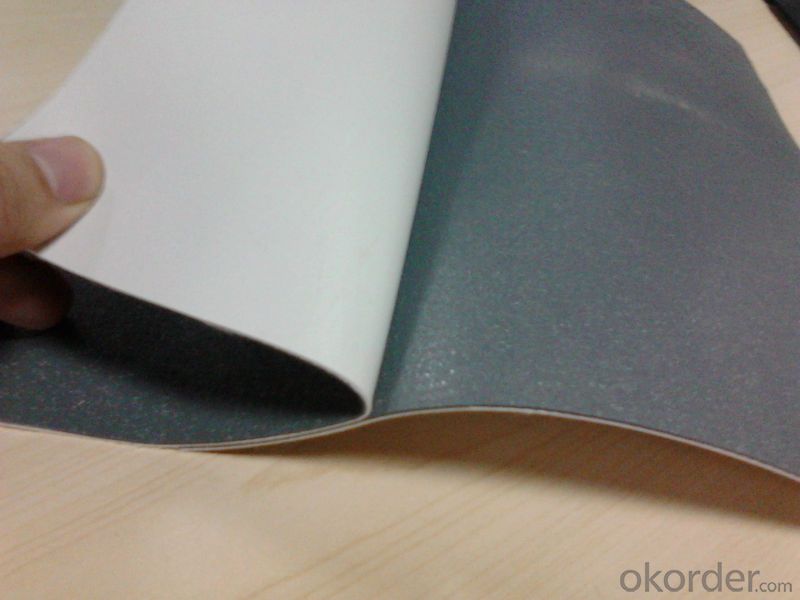
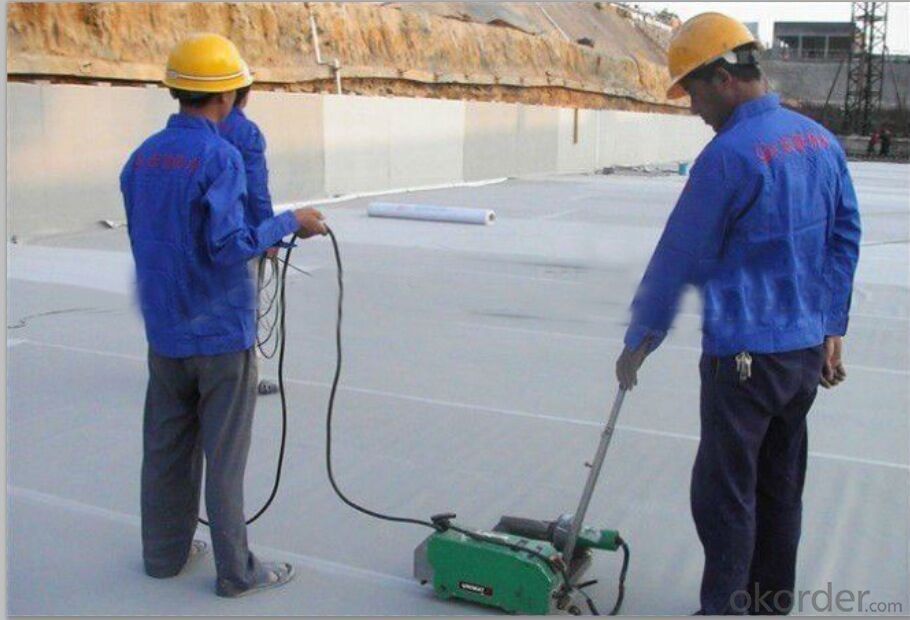
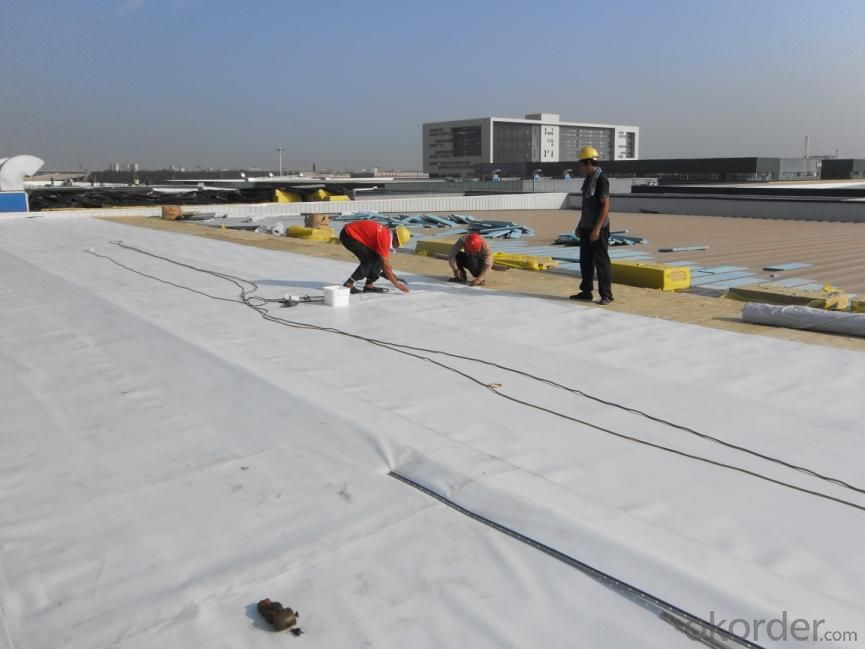
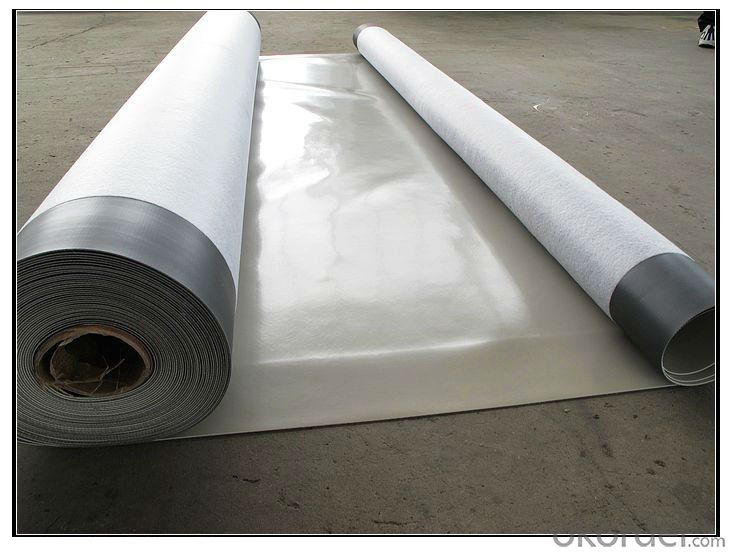
FAQ of PVC Waterproofing Membrane with Smooth Surface Assification:
1. Can you produce 4m width?
Yes, no problem for us. We have four bases in China, largest one in this field.
2. How many quantity in one 20'' container for 1.2mm and 1.5mm?
480rolls, 11520m2 for 1.2mm and 400rolls, 9600m2 for 1.5mm
3. Can you provide free samples?
Yes, our samples are free, but express fees usually on buyer's account.
- Q: Can a waterproofing membrane be used in mining or excavation projects?
- Indeed, mining or excavation projects can make use of a waterproofing membrane. Such membranes are specifically crafted to thwart the infiltration of water and other liquids, making them a perfect remedy for regions susceptible to water intrusion, such as mines or excavations. Typically, these membranes are fashioned from resilient substances like rubber or bitumen, and they are affixed to the walls, floors, or roofs of these structures to establish an impervious barricade. By employing a waterproofing membrane, mining and excavation projects can diminish the likelihood of water harm, safeguard equipment and infrastructure, and guarantee a secure working environment for laborers.
- Q: Is a waterproofing membrane resistant to gasoline or other petroleum-based substances?
- Yes, a waterproofing membrane is generally resistant to gasoline and other petroleum-based substances.
- Q: Is a waterproofing membrane resistant to hydrocarbons or oil spills?
- Typically, a waterproofing membrane exhibits resistance against hydrocarbons and oil spills. Its primary purpose is to create a barrier that prevents water penetration and protects the underlying surfaces from moisture damage. These membranes are commonly made from materials such as modified bitumen, polyurethane, or PVC, all of which possess excellent chemical resistance, including towards hydrocarbons and oil. This resistance guarantees that the membrane remains intact and effective even when exposed to substances like oil spills or hydrocarbon-based liquids. However, it is crucial to note that the specific resistance may vary depending on the type and quality of the selected waterproofing membrane. Therefore, it is essential to choose a membrane that is specifically engineered to withstand the intended environment and potential chemical exposures.
- Q: Can a waterproofing membrane be used for water fountains or decorative features?
- Yes, a waterproofing membrane can be used for water fountains or decorative features. Waterproofing membranes are designed to provide a protective barrier against water penetration and can be applied to various surfaces, including those used in water fountains and decorative features. These membranes are typically made from materials such as rubber, bitumen, or liquid-applied coatings, which offer excellent waterproofing properties. By applying a waterproofing membrane, you can ensure that water does not seep into the underlying structure and cause damage. This is particularly important for water fountains and decorative features as they involve constant exposure to water. Additionally, waterproofing membranes can also help prevent leaks, cracks, and other potential issues that may arise from water exposure, thus prolonging the lifespan of the fountain or decorative feature.
- Q: Can a waterproofing membrane be used for convention centers or exhibition halls?
- Yes, a waterproofing membrane can be used for convention centers or exhibition halls. Waterproofing membranes are commonly used in construction to protect buildings from water damage and leakage. Given the potential for water infiltration in large spaces like convention centers or exhibition halls, using a waterproofing membrane can help ensure the integrity and durability of the structure by preventing water penetration and potential damage.
- Q: Can a waterproofing membrane be tested for quality or performance?
- Yes, a waterproofing membrane can be tested for quality and performance. Several tests can be conducted to evaluate the effectiveness and durability of the membrane. One common test is the water penetration test, where the membrane is subjected to a certain amount of water pressure to determine if it allows any water to pass through. Another test is the adhesion test, where the strength of the membrane's bond to the substrate is evaluated. Additionally, tests can be conducted to assess the membrane's resistance to chemicals, UV radiation, temperature fluctuations, and physical stress. These tests help determine if the membrane meets the required standards and can perform effectively in various conditions.
- Q: Can a waterproofing membrane protect against mold or mildew growth?
- A waterproofing membrane is capable of protecting against the growth of mold or mildew, as they thrive in environments that are damp and moist. The membrane acts as a barrier, preventing water from entering the building structure. This effectively keeps the area dry and greatly reduces the likelihood of mold or mildew growth. Furthermore, waterproofing membranes often contain anti-microbial properties that further hinder the growth of mold and mildew. Nevertheless, it is important to remember that while a waterproofing membrane can offer substantial protection against mold and mildew, it is not a foolproof solution. It is crucial to ensure proper ventilation and carry out regular maintenance to prevent these issues.
- Q: Can a waterproofing membrane be used on bridge decks?
- Yes, a waterproofing membrane can be used on bridge decks. Bridge decks are exposed to various weather conditions, including rain, snow, and ice, which can cause damage over time. Applying a waterproofing membrane on bridge decks can help to protect the concrete from moisture penetration, preventing deterioration and extending the lifespan of the bridge. Additionally, the waterproofing membrane serves as a barrier against chloride ions, which can accelerate the corrosion of reinforcing steel in the bridge deck. Therefore, using a waterproofing membrane on bridge decks is a common practice in bridge construction and maintenance to ensure their durability and longevity.
- Q: Asphalt waterproofing membrane and polymer waterproofing membrane
- It is a kind of self-adhesive polymer with self-adhesive function, such as butyl rubber and anti-sticking layer, which can be compounded with a certain thickness of the modified asphalt waterproofing membrane. Modified asphalt waterproofing membrane.
- Q: How do waterproofing membranes adhere to surfaces?
- To achieve adherence between surfaces and waterproofing membranes, a dual approach of mechanical and chemical bonding is employed. Prior to the application of the membrane, it is imperative that the surfaces are thoroughly cleaned, dried, and devoid of loose particles or contaminants. Mechanical bonding is established through the utilization of textured or rough surfaces on many waterproofing membranes. These surfaces allow for improved traction on the substrate, resulting in more points of contact between the membrane and the surface. Consequently, the adhesion strength is heightened. Additionally, some membranes possess a self-adhesive backing, which enables them to directly adhere to the substrate without necessitating additional adhesives. Chemical bonding also plays an instrumental role in adhesion. Waterproofing membranes are commonly composed of materials such as modified bitumen, EPDM rubber, or PVC, which inherently possess adhesive properties. These materials are purposely designed to chemically bond with the substrate, creating a robust and enduring seal. In certain circumstances, the utilization of supplementary adhesives or primers may be required to bolster the adhesion of the waterproofing membrane. These products are specifically formulated to enhance the bond between the membrane and the surface, guaranteeing long-lasting waterproofing protection. In summary, the adhesion of waterproofing membranes to surfaces is accomplished through a combination of mechanical and chemical bonding. Furthermore, the incorporation of specialized adhesives or primers, when necessary, ensures that the membrane is securely affixed to the substrate, effectively preventing water intrusion and potential damage.
Send your message to us
PVC Waterproofing Membrane with Smooth Surface Assification
- Loading Port:
- Shanghai
- Payment Terms:
- TT OR LC
- Min Order Qty:
- 20000 m²
- Supply Capability:
- 5000000 m²/month
OKorder Service Pledge
OKorder Financial Service
Similar products
Hot products
Hot Searches
Related keywords
